Diesel Alfa Romeo Giulia 2016 Owner's Manual
[x] Cancel search | Manufacturer: ALFA ROMEO, Model Year: 2016, Model line: Giulia, Model: Alfa Romeo Giulia 2016Pages: 204, PDF Size: 4.95 MB
Page 53 of 204
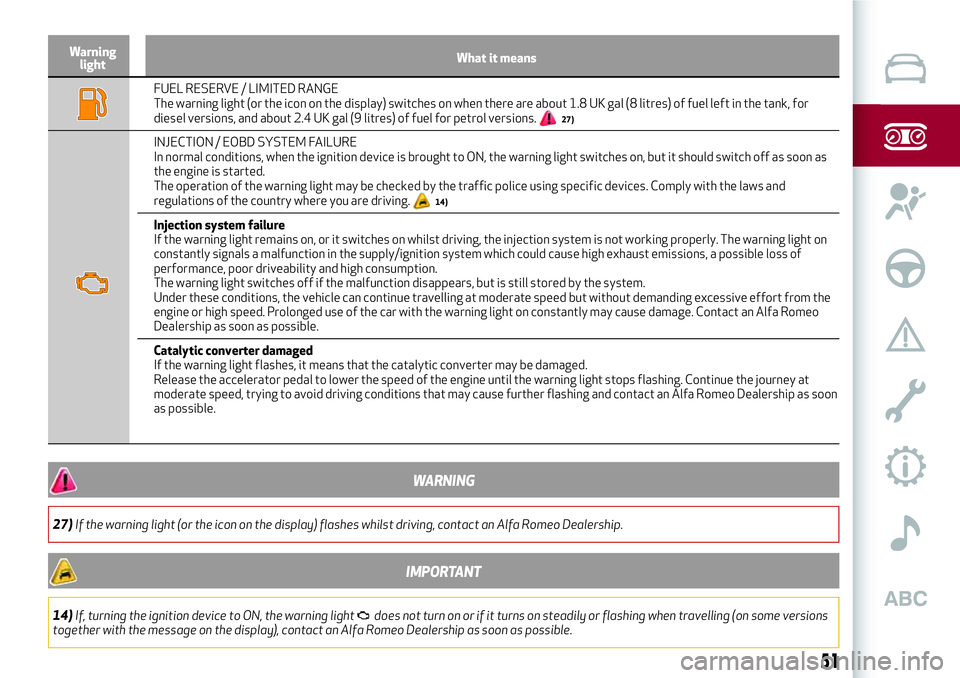
Warning
lightWhat it means
FUEL RESERVE / LIMITED RANGE
The warning light (or the icon on the display) switches on when there are about 1.8 UK gal (8 litres) of fuel left in the tank, for
diesel versions, and about 2.4 UK gal (9 litres) of fuel for petrol versions.
27)
INJECTION / EOBD SYSTEM FAILURE
In normal conditions, when the ignition device is brought to ON, the warning light switches on, but it should switch off as soon as
the engine is started.
The operation of the warning light may be checked by the traffic police using specific devices. Comply with the laws and
regulations of the country where you are driving.
14)
Injection system failure
If the warning light remains on, or it switches on whilst driving, the injection system is not working properly. The warning light on
constantly signals a malfunction in the supply/ignition system which could cause high exhaust emissions, a possible loss of
performance, poor driveability and high consumption.
The warning light switches off if the malfunction disappears, but is still stored by the system.
Under these conditions, the vehicle can continue travelling at moderate speed but without demanding excessive effort from the
engine or high speed. Prolonged use of the car with the warning light on constantly may cause damage. Contact an Alfa Romeo
Dealership as soon as possible.
Catalytic converter damaged
If the warning light flashes, it means that the catalytic converter may be damaged.
Release the accelerator pedal to lower the speed of the engine until the warning light stops flashing. Continue the journey at
moderate speed, trying to avoid driving conditions that may cause further flashing and contact an Alfa Romeo Dealership as soon
as possible.
WARNING
27)If the warning light (or the icon on the display) flashes whilst driving, contact an Alfa Romeo Dealership.
IMPORTANT
14)If, turning the ignition device to ON, the warning lightdoes not turn on or if it turns on steadily or flashing when travelling (on some versions
together with the message on the display), contact an Alfa Romeo Dealership as soon as possible.
51
Page 59 of 204

Symbol What it means
FUEL CUT-OFF SYSTEM OPERATION
The symbol switches on in the event of fuel cut-off system intervention.
For reactivating the fuel cut-off system, refer to the description in the "Fuel cut-off system" section in the "In an emergency"
chapter. If it is not possible to restore the fuel supply, contact an Alfa Romeo Dealership.
PARK SENSORS SYSTEM FAILURE
Lights up when the system has failed or is not available.
Contact an Alfa Romeo Dealership to have the system checked.
POSSIBLE ICE ON ROAD
The symbol turns on when the outside temperature falls to or below 37°F (3°C).
ENGINE OIL DETERIORATED
(where provided)
The symbol is displayed only for a limited time.
IMPORTANT After the first indication, each time the engine is started the symbol will continue to switch on as described above
until the oil is changed.
If the symbol flashes, this does not mean that there is a fault on the vehicle, rather it simply reports that it is now necessary to
change the oil as a result of regular use of the vehicle. The deterioration of engine oil is accelerated by using the vehicle for short
drives, preventing the engine from reaching operating temperature.
Contact an Alfa Romeo Dealership as soon as possible.
17)
IMPORTANT
17)Deteriorated engine oil should be replaced as soon as possible after the symbol is switched on, and never more than 500 km after it first
switches on. Failure to observe the above may result in severe damage to the engine and invalidate the warranty. When this symbol comes on, it
does not mean that the level of engine oil is low, so if it flashes you do not need to top up the engine oil.
Symbol What it means
GLOW PLUG PREHEATING (Diesel versions)
This warning light comes on when the ignition device is brought to ON and will switch off when the glow plugs have reached the
preset temperature. The engine can be started as soon as the warning light switches off.
IMPORTANT In mild or high temperature conditions, the warning light comes on for a very short time only.
57
Page 60 of 204
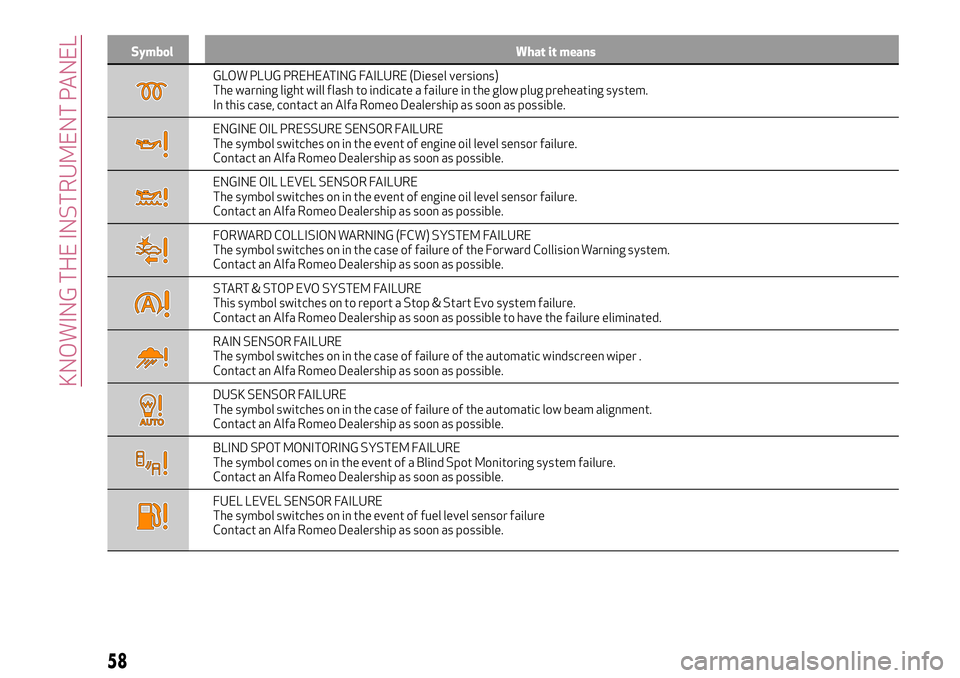
Symbol What it means
GLOW PLUG PREHEATING FAILURE (Diesel versions)
The warning light will flash to indicate a failure in the glow plug preheating system.
In this case, contact an Alfa Romeo Dealership as soon as possible.
ENGINE OIL PRESSURE SENSOR FAILURE
The symbol switches on in the event of engine oil level sensor failure.
Contact an Alfa Romeo Dealership as soon as possible.
ENGINE OIL LEVEL SENSOR FAILURE
The symbol switches on in the event of engine oil level sensor failure.
Contact an Alfa Romeo Dealership as soon as possible.
FORWARD COLLISION WARNING (FCW) SYSTEM FAILURE
The symbol switches on in the case of failure of the Forward Collision Warning system.
Contact an Alfa Romeo Dealership as soon as possible.
START & STOP EVO SYSTEM FAILURE
This symbol switches on to report a Stop & Start Evo system failure.
Contact an Alfa Romeo Dealership as soon as possible to have the failure eliminated.
RAIN SENSOR FAILURE
The symbol switches on in the case of failure of the automatic windscreen wiper .
Contact an Alfa Romeo Dealership as soon as possible.
DUSK SENSOR FAILURE
The symbol switches on in the case of failure of the automatic low beam alignment.
Contact an Alfa Romeo Dealership as soon as possible.
BLIND SPOT MONITORING SYSTEM FAILURE
The symbol comes on in the event of a Blind Spot Monitoring system failure.
Contact an Alfa Romeo Dealership as soon as possible.
FUEL LEVEL SENSOR FAILURE
The symbol switches on in the event of fuel level sensor failure
Contact an Alfa Romeo Dealership as soon as possible.
58
KNOWING THE INSTRUMENT PANEL
Page 62 of 204
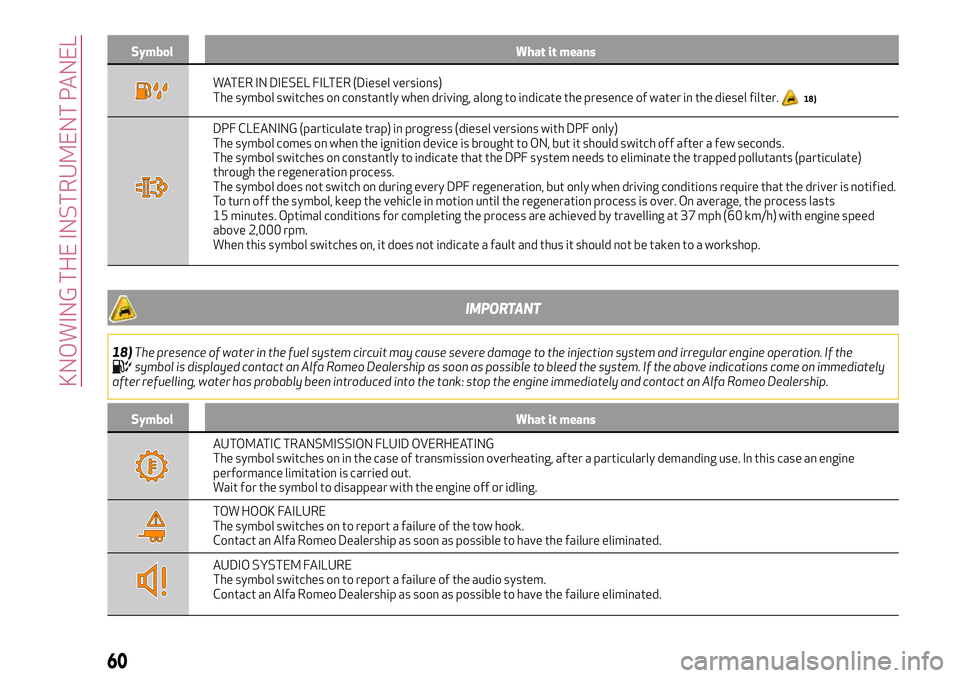
Symbol What it means
WATER IN DIESEL FILTER (Diesel versions)
The symbol switches on constantly when driving, along to indicate the presence of water in the diesel filter.18)
DPF CLEANING (particulate trap) in progress (diesel versions with DPF only)
The symbol comes on when the ignition device is brought to ON, but it should switch off after a few seconds.
The symbol switches on constantly to indicate that the DPF system needs to eliminate the trapped pollutants (particulate)
through the regeneration process.
The symbol does not switch on during every DPF regeneration, but only when driving conditions require that the driver is notified.
To turn off the symbol, keep the vehicle in motion until the regeneration process is over. On average, the process lasts
15 minutes. Optimal conditions for completing the process are achieved by travelling at 37 mph (60 km/h) with engine speed
above 2,000 rpm.
When this symbol switches on, it does not indicate a fault and thus it should not be taken to a workshop.
IMPORTANT
18)The presence of water in the fuel system circuit may cause severe damage to the injection system and irregular engine operation. If thesymbol is displayed contact an Alfa Romeo Dealership as soon as possible to bleed the system. If the above indications come on immediately
after refuelling, water has probably been introduced into the tank: stop the engine immediately and contact an Alfa Romeo Dealership.
Symbol What it means
AUTOMATIC TRANSMISSION FLUID OVERHEATING
The symbol switches on in the case of transmission overheating, after a particularly demanding use. In this case an engine
performance limitation is carried out.
Wait for the symbol to disappear with the engine off or idling.
TOW HOOK FAILURE
The symbol switches on to report a failure of the tow hook.
Contact an Alfa Romeo Dealership as soon as possible to have the failure eliminated.
AUDIO SYSTEM FAILURE
The symbol switches on to report a failure of the audio system.
Contact an Alfa Romeo Dealership as soon as possible to have the failure eliminated.
60
KNOWING THE INSTRUMENT PANEL
Page 104 of 204
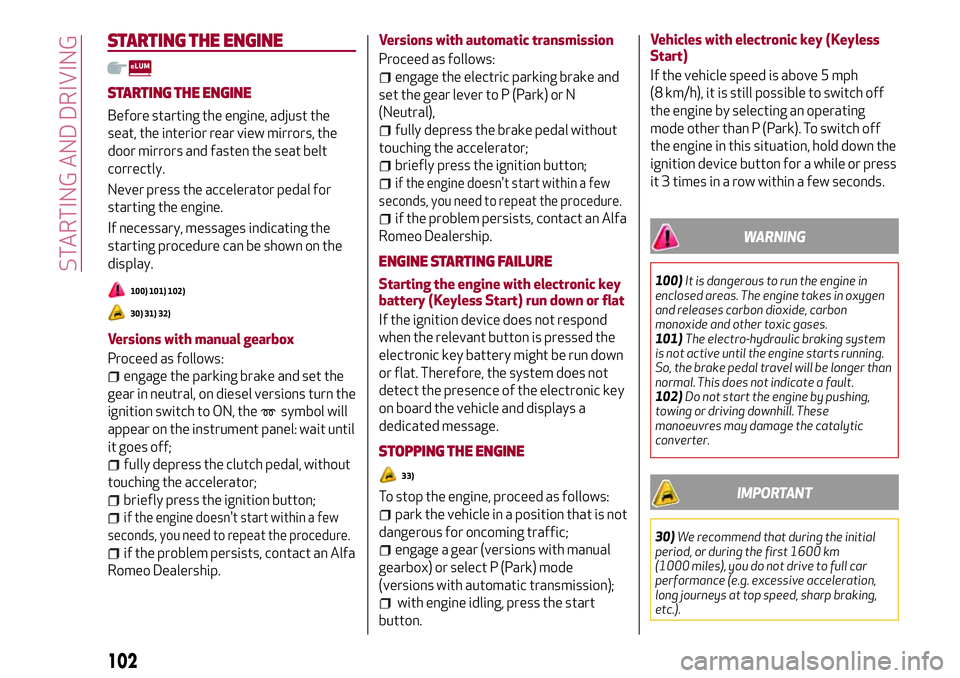
STARTING THE ENGINE
STARTING THE ENGINE
Before starting the engine, adjust the
seat, the interior rear view mirrors, the
door mirrors and fasten the seat belt
correctly.
Never press the accelerator pedal for
starting the engine.
If necessary, messages indicating the
starting procedure can be shown on the
display.
100) 101) 102)
30) 31) 32)
Versions with manual gearbox
Proceed as follows:
engage the parking brake and set the
gear in neutral, on diesel versions turn the
ignition switch to ON, the
symbol will
appear on the instrument panel: wait until
it goes off;
fully depress the clutch pedal, without
touching the accelerator;
briefly press the ignition button;
if the engine doesn't start within a few
seconds, you need to repeat the procedure.
if the problem persists, contact an Alfa
Romeo Dealership.Versions with automatic transmission
Proceed as follows:
engage the electric parking brake and
set the gear lever to P (Park) or N
(Neutral),
fully depress the brake pedal without
touching the accelerator;
briefly press the ignition button;
if the engine doesn't start within a few
seconds, you need to repeat the procedure.
if the problem persists, contact an Alfa
Romeo Dealership.
ENGINE STARTING FAILURE
Starting the engine with electronic key
battery (Keyless Start) run down or flat
If the ignition device does not respond
when the relevant button is pressed the
electronic key battery might be run down
or flat. Therefore, the system does not
detect the presence of the electronic key
on board the vehicle and displays a
dedicated message.
STOPPING THE ENGINE
33)
To stop the engine, proceed as follows:
park the vehicle in a position that is not
dangerous for oncoming traffic;
engage a gear (versions with manual
gearbox) or select P (Park) mode
(versions with automatic transmission);
with engine idling, press the start
button.Vehicles with electronic key (Keyless
Start)
If the vehicle speed is above 5 mph
(8 km/h), it is still possible to switch off
the engine by selecting an operating
mode other than P (Park). To switch off
the engine in this situation, hold down the
ignition device button for a while or press
it 3 times in a row within a few seconds.
WARNING
100)It is dangerous to run the engine in
enclosed areas. The engine takes in oxygen
and releases carbon dioxide, carbon
monoxide and other toxic gases.
101)The electro-hydraulic braking system
is not active until the engine starts running.
So, the brake pedal travel will be longer than
normal. This does not indicate a fault.
102)Do not start the engine by pushing,
towing or driving downhill. These
manoeuvres may damage the catalytic
converter.
IMPORTANT
30)We recommend that during the initial
period, or during the first 1600 km
(1000 miles), you do not drive to full car
performance (e.g. excessive acceleration,
long journeys at top speed, sharp braking,
etc.).
102
STARTING AND DRIVING
Page 120 of 204
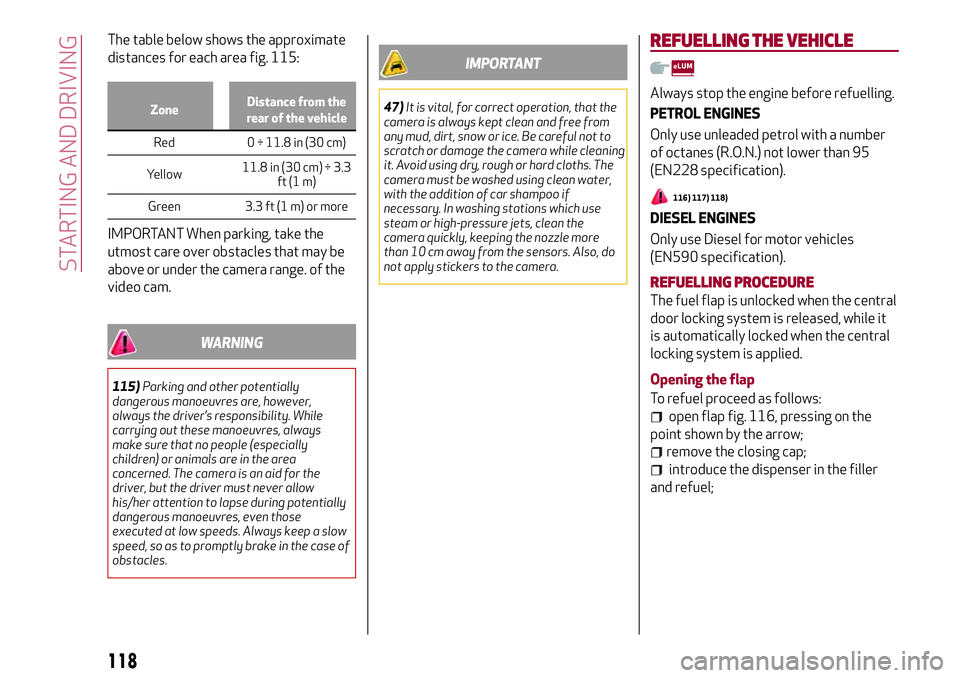
The table below shows the approximate
distances for each area fig. 115:
ZoneDistance from the
rear of the vehicle
Red 0 ÷ 11.8 in (30 cm)
Yellow11.8 in
(30 cm) ÷ 3.3
ft (1 m)
Green 3.3 ft (1 m) or more
IMPORTANT When parking, take the
utmost care over obstacles that may be
above or under the camera range. of the
video cam.
WARNING
115)Parking and other potentially
dangerous manoeuvres are, however,
always the driver’s responsibility. While
carrying out these manoeuvres, always
make sure that no people (especially
children) or animals are in the area
concerned. The camera is an aid for the
driver, but the driver must never allow
his/her attention to lapse during potentially
dangerous manoeuvres, even those
executed at low speeds. Always keep a slow
speed, so as to promptly brake in the case of
obstacles.
IMPORTANT
47)It is vital, for correct operation, that the
camera is always kept clean and free from
any mud, dirt, snow or ice. Be careful not to
scratch or damage the camera while cleaning
it. Avoid using dry, rough or hard cloths. The
camera must be washed using clean water,
with the addition of car shampoo if
necessary. In washing stations which use
steam or high-pressure jets, clean the
camera quickly, keeping the nozzle more
than 10 cm away from the sensors. Also, do
not apply stickers to the camera.
REFUELLING THE VEHICLE
Always stop the engine before refuelling.
PETROL ENGINES
Only use unleaded petrol with a number
of octanes (R.O.N.) not lower than 95
(EN228 specification).
116) 117) 118)
DIESEL ENGINES
Only use Diesel for motor vehicles
(EN590 specification).
REFUELLING PROCEDURE
The fuel flap is unlocked when the central
door locking system is released, while it
is automatically locked when the central
locking system is applied.
Opening the flap
To refuel proceed as follows:
open flap fig. 116, pressing on the
point shown by the arrow;
remove the closing cap;
introduce the dispenser in the filler
and refuel;
118
STARTING AND DRIVING
Page 121 of 204
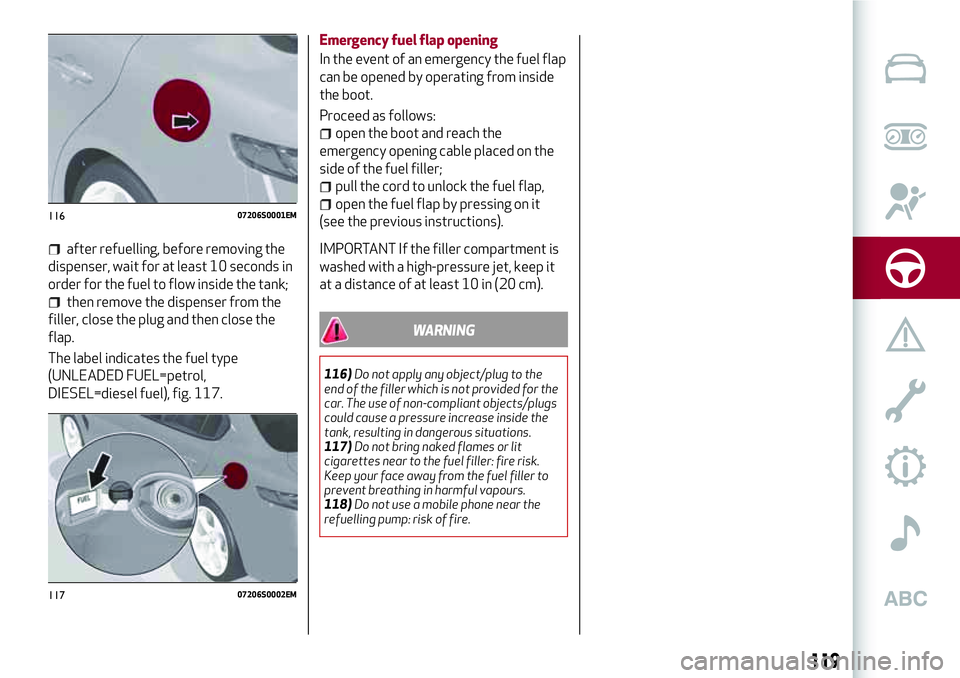
after refuelling, before removing the
dispenser, wait for at least 10 seconds in
order for the fuel to flow inside the tank;
then remove the dispenser from the
filler, close the plug and then close the
flap.
The label indicates the fuel type
(UNLEADED FUEL=petrol,
DIESEL=diesel fuel), fig. 117.Emergency fuel flap opening
In the event of an emergency the fuel flap
can be opened by operating from inside
the boot.
Proceed as follows:
open the boot and reach the
emergency opening cable placed on the
side of the fuel filler;
pull the cord to unlock the fuel flap,
open the fuel flap by pressing on it
(see the previous instructions).
IMPORTANT If the filler compartment is
washed with a high-pressure jet, keep it
at a distance of at least 10 in (20 cm).
WARNING
116)Do not apply any object/plug to the
end of the filler which is not provided for the
car. The use of non-compliant objects/plugs
could cause a pressure increase inside the
tank, resulting in dangerous situations.
117)Do not bring naked flames or lit
cigarettes near to the fuel filler: fire risk.
Keep your face away from the fuel filler to
prevent breathing in harmful vapours.
118)Do not use a mobile phone near the
refuelling pump: risk of fire.
11607206S0001EM
11707206S0002EM
119
Page 145 of 204
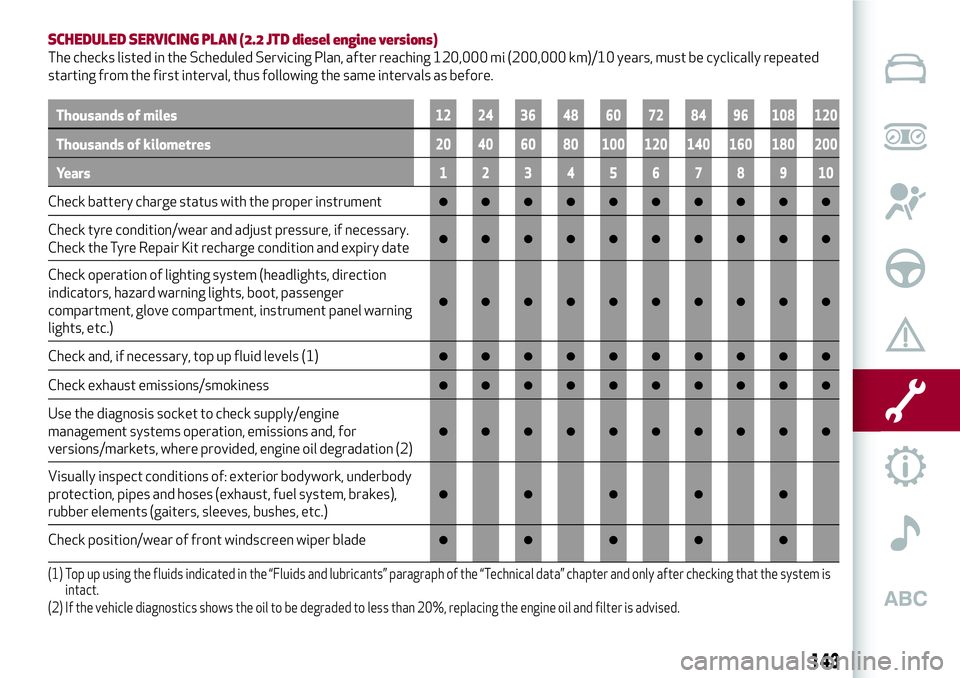
SCHEDULED SERVICING PLAN (2.2 JTD diesel engine versions)
The checks listed in the Scheduled Servicing Plan, after reaching 120,000 mi (200,000 km)/10 years, must be cyclically repeated
starting from the first interval, thus following the same intervals as before.
Thousands of miles12 24 36 48 60 72 84 96 108 120
Thousands of kilometres20 40 60 80 100 120 140 160 180 200
Years12345678910
Check battery charge status with the proper instrument●●●●●●●●●●
Check tyre condition/wear and adjust pressure, if necessary.
Check the Tyre Repair Kit recharge condition and expiry date●●●●●●●●●●
Check operation of lighting system (headlights, direction
indicators, hazard warning lights, boot, passenger
compartment, glove compartment, instrument panel warning
lights, etc.)
●●●●●●●●●●
Check and, if necessary, top up fluid levels (1)●●●●●●●●●●
Check exhaust emissions/smokiness●●●●●●●●●●
Use the diagnosis socket to check supply/engine
management systems operation, emissions and, for
versions/markets, where provided, engine oil degradation (2)
●●●●●●●●●●
Visually inspect conditions of: exterior bodywork, underbody
protection, pipes and hoses (exhaust, fuel system, brakes),
rubber elements (gaiters, sleeves, bushes, etc.)
●●●●●
Check position/wear of front windscreen wiper blade●●●●●
(1) Top up using the fluids indicated in the “Fluids and lubricants” paragraph of the “Technical data” chapter and only after checking that the system is
intact.
(2) If the vehicle diagnostics shows the oil to be degraded to less than 20%, replacing the engine oil and filter is advised.
143
Page 148 of 204
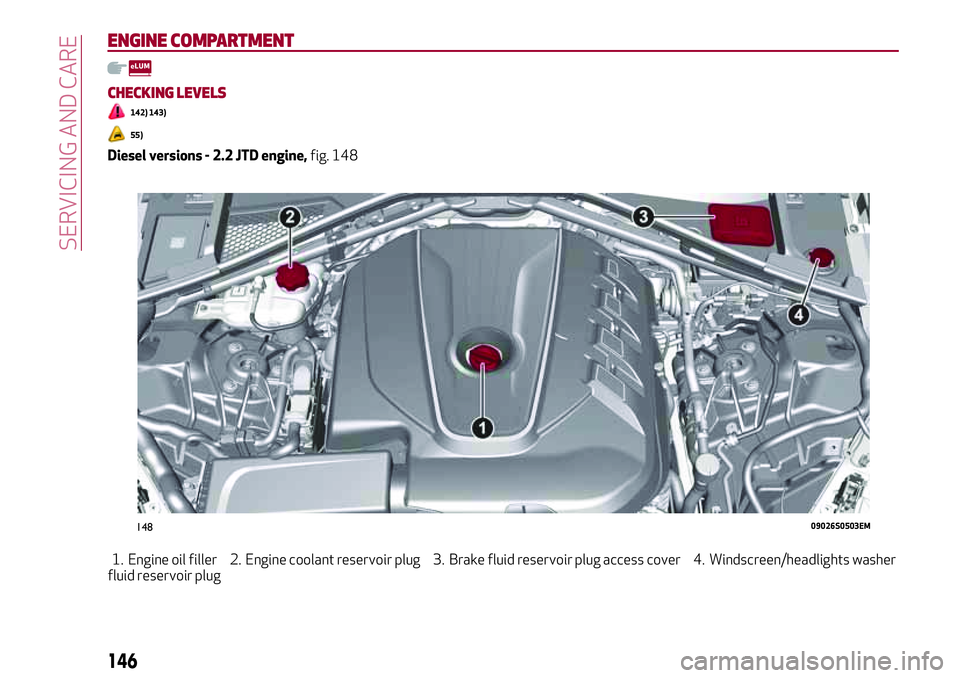
ENGINE COMPARTMENT
CHECKING LEVELS
142) 143)
55)
Diesel versions - 2.2 JTD engine,fig. 148
1. Engine oil filler 2. Engine coolant reservoir plug 3. Brake fluid reservoir plug access cover 4. Windscreen/headlights washer
fluid reservoir plug
14809026S0503EM
146
SERVICING AND CARE
Page 160 of 204
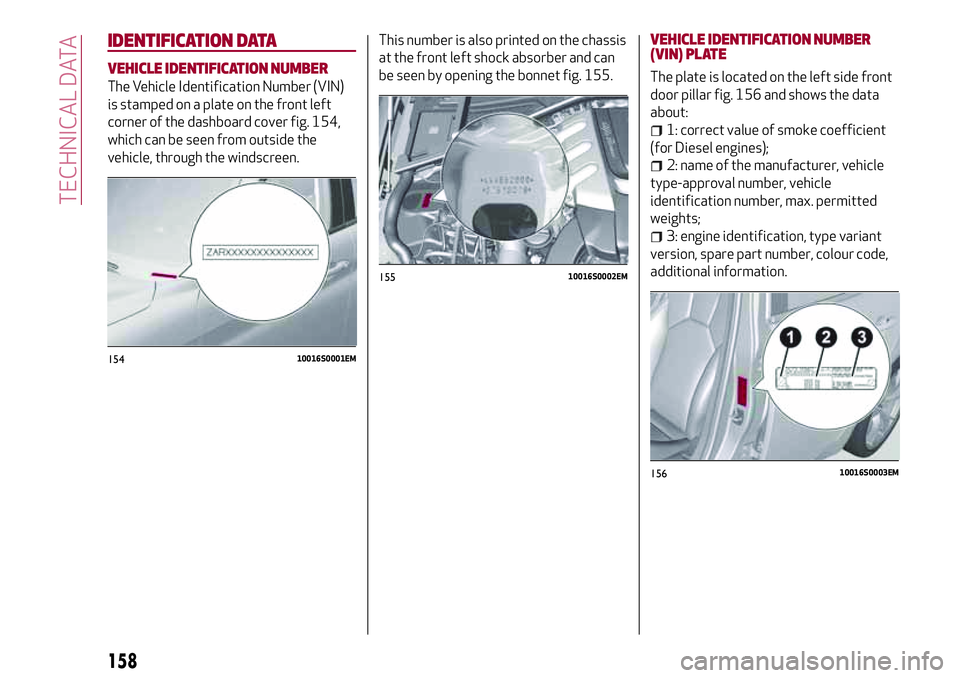
IDENTIFICATION DATA
VEHICLE IDENTIFICATION NUMBER
The Vehicle Identification Number (VIN)
is stamped on a plate on the front left
corner of the dashboard cover fig. 154,
which can be seen from outside the
vehicle, through the windscreen.This number is also printed on the chassis
at the front left shock absorber and can
be seen by opening the bonnet fig. 155.
VEHICLE IDENTIFICATION NUMBER
(VIN) PLATE
The plate is located on the left side front
door pillar fig. 156 and shows the data
about:
1: correct value of smoke coefficient
(for Diesel engines);
2: name of the manufacturer, vehicle
type-approval number, vehicle
identification number, max. permitted
weights;
3: engine identification, type variant
version, spare part number, colour code,
additional information.
15410016S0001EM
15510016S0002EM
15610016S0003EM
158
TECHNICAL DATA